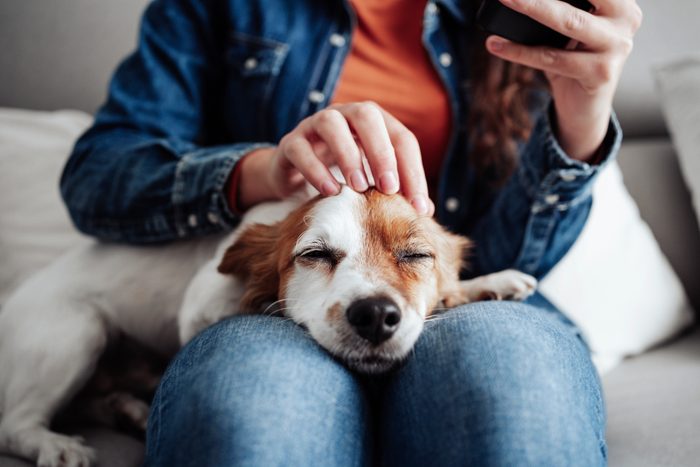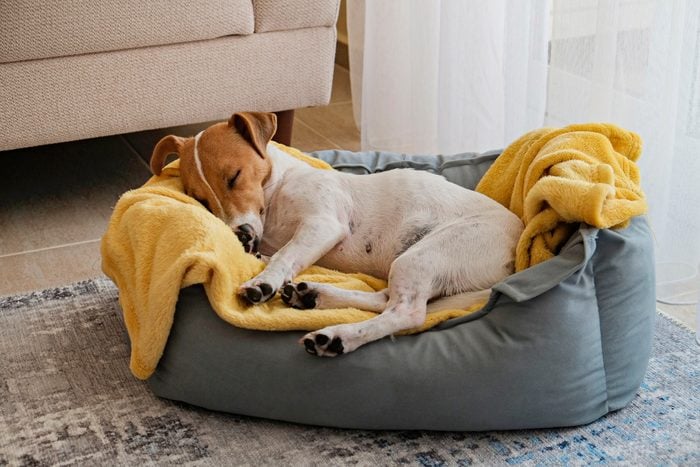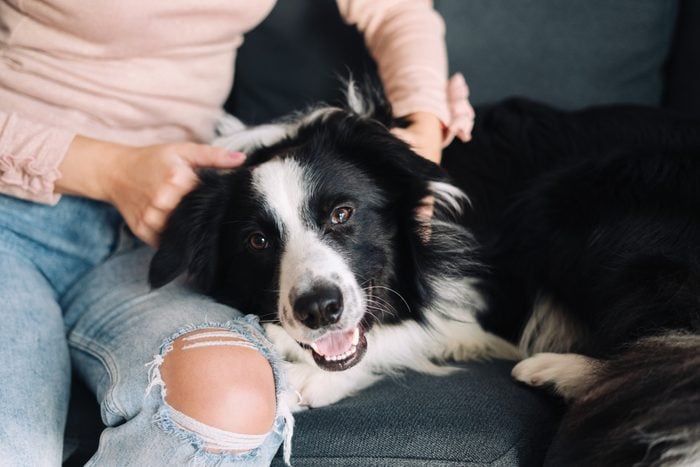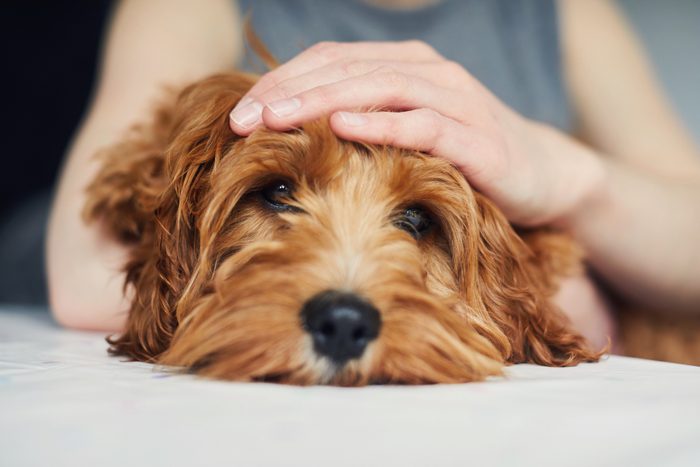
Your four-legged bestie brings a lot of value to your life—from getting you out for walks to giving cuddles that some health experts say can actually be good for blood pressure and even lengthen your lifespan.
So when you’re loving on your pooch in appreciation for all that goodness, dog massage experts from around the country say some minor massage techniques can make your snuggle session majorly therapeutic for your pup.
Alyson Snelling, NCCMT, CCFT, RP is a certified canine massage therapist in St. Louis, MO who says that from head to toe, dog massages come with a wide range of health benefits. “[Dog massage] offers so many physical and emotional benefits that you could consider it as essential a component of health care as food, water, shelter, exercise, and grooming.” A dog massage is not just frivolous pampering—massage and bodywork can significantly contribute to your dog’s general health, energy, and quality of life.
Best of all, it’s simple to massage your dog. Read on, and watch our dog massage video, using Snelling’s steps, to demonstrate how to massage your dog in action.

The benefits of dog massage
“By incorporating massage into a dog’s routine, you can help reduce unnecessary stress to the joints, risk of injury, development of osteoarthritis, and faster degeneration of affected joints,” Snelling says. Keep in mind, your pup could get used to this spa-at-home experience fast—so the right frequency for your dog’s massage will depend on their age, activity level, or specific orthopedic conditions or injuries that may be limiting their natural mobility.
Here’s how often to massage your dog
For active dogs, massage can help speed recovery, keep joints flexible, and reduce potential injury. You can give your dog a massage before or after activity—but, Snelling says, “regular maintenance check-ins [at least] every four to eight weeks can keep them feeling their best,” she says.
Older or arthritic dogs can benefit from more frequent sessions to release tension, increase joint mobility, reduce pain, and boost the immune system. “A weekly or every-other week routine is recommended for these conditions.”
Massages also release relaxing, feel-good endorphins in your dog, and making it a regular practice “really strengthens the bond between the owner and the dog,” adds Janet Jonas, CNMT, a certified canine massage therapist in North Carolina.
There is one caveat: If your dog is showing signs of stiffness, reduced mobility like trouble climbing stairs, lameness, or sudden behavioral changes, there is a high chance they are dealing with some level of pain, Snelling says. “The first thing to do in these situations is consult with your veterinarian for diagnosis and discuss a plan for treatment,” which can include at-home and professional massage.

How to massage your dog at home
“One of the most important things you can do before you actually massage your dog is a snout-to-tail assessment, which you should do weekly,” says Jonas. Look and feel for any changes, like cracks in their nose, ear odor, changes to their coat, lumps or bumps, abrasions on the paws, changes in gum color (which should be pink), and nail length. After checking in with how your dog is doing, there are a few techniques the experts recommend for at-home dog massage.
Passive touch
“With this technique, you are resting your hand on the dog and simply being present,” Snelling says. “Think of when you rest your hand on your thigh—after several seconds, you feel a warmth beneath your palm.” This warmth transfers into body tissues, which softens tension and increases circulation.
How to do it:
-
Place your relaxed hands onto the dog, like over the hips, shoulders, or along the back.
-
Let your hand rest along the shape of the body part for about 10 to 30 seconds.
“Passive touch can be used at any time, and the application is very superficial in pressure,” Snelling says. “This technique uses both hands and can be applied anywhere on the body where the dog has tension or soreness.”
Effleurage
This is a Swedish massage technique using long, sweeping strokes. “Effleurage warms the tissue by increasing circulation and lymph function, softens tissue, and relaxes musculature to create a sense of well-being and connectedness,” Snelling says.
How to do effleurage massage on your dog:
-
Place your hands lightly on the dog, with hands relaxed and fingers held together.
-
Move in slow, fluid, sweeping motions in the direction of the fur and then back against it, taking extra care with longer-hair dogs to not snag their coat.
-
Use just enough pressure to engage the skin.
-
Your hands don’t need to stay in unison, just find a relaxing rhythm that feels natural.
As you pass your hands along the dog’s body, pay attention to the different textures and make mental notes of any areas that feel particularly tight or sensitive to the dog. “Normal muscle tissue should feel like a ripe avocado, with a little give to the structure,” Snelling says.
Petrissage
“Many dogs find this very, very relaxing,” Jonas says of petrissage massage. “It’s a motion that’s kind of like when you knead bread.” This technique helps release muscle tension, promote circulation, and can ease anxious pets.
How to do it:
-
Use your fingers and thumbs to lightly grab areas with loose skin, like the back of the neck and shoulders
-
Very gently (and slowly) massage the skin in kneading or rolling motions.
Snelling adds that with any of these techniques, you can apply a light rub to common pressure points, encouraging relaxation: The chest at the sternum, the top of the nose between the eyes, and the base of the tail.
Everything Veterinarians Want You to Know About Hypoallergenic Dogs

What not to do when you massage your dog
“Monitoring a dog’s body language is incredibly important when providing massage,” Snelling says. “Dogs communicate through behavioral cues and signals, and often these are very subtle.” You’ll know they’re enjoying the massage if you see a softness of facial features, they settle into a comfortable position, or let out a deep sigh. “If you’re ever unsure, take a moment to check in by stopping and see if the dog cues you to continue,” she says. “If they walk off, don’t take it personally! They’re either done with the session or not interested at that time.”
But the biggest error people make is applying too much pressure during their dog’s massage, Jonas says. “Less is always better,” she explains. “Think about if you touched your eyeball—that’s about the amount of pressure you should be using.”
There’s also a limit to what you should do with at-home dog massage therapy. “There are other techniques we use, like vibration and rocking, compression, and range of motion exercises that people shouldn’t do at home,” Jonas says. These types of massage therapy can be very effective in helping dogs recover from an injury or improve their mobility in old age, but should only be done by a certified professional.
Then there are some areas experts say to steer clear of during at-home massage. “We tell folks to stay away from the neck because there’s a vagus nerve up there, and we don’t want you to press on their spine,” Jonas says. “You don’t want to press on any kind of bones, either—dogs have nerves under their armpits and in their elbows, behind the knee; these are called engagement sites, and you want to stay away from those.”
- Vets Share Their 5 Best Tips for Safer Dog Walks—and 5 Things Never to Do
- An Obesity Doctor Reveals the Groundbreaking Truth About the Effect of Aging on Your Metabolism
- Research Shows This Gross (but Common) Behavior May Increase Alzheimer’s Risk
- The 9 Best Dog Breeds That Help With Anxiety, According to Animal Experts
